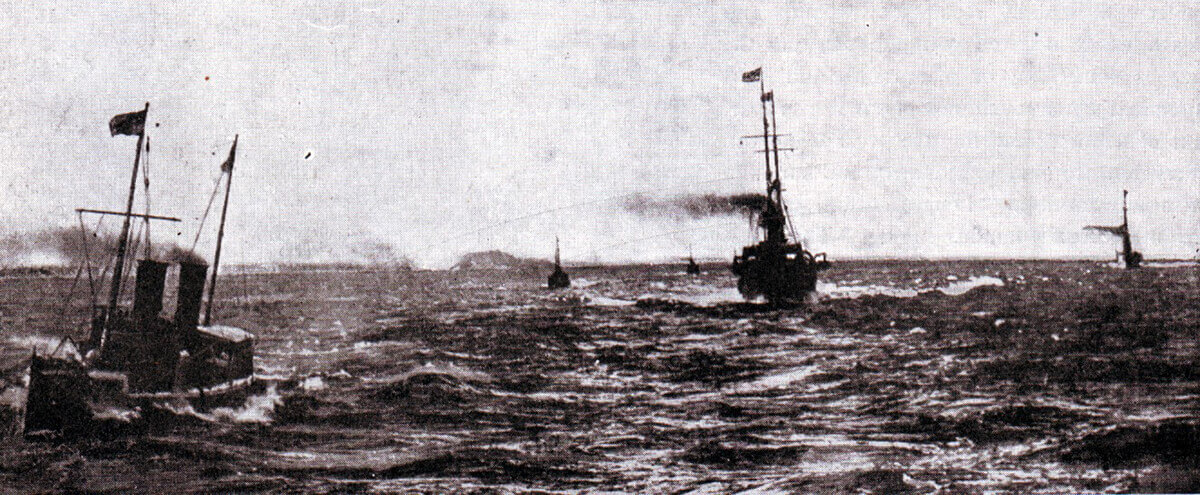The action on 17th October 1914 in the First World War, where a British light cruiser and four destroyers caught and sank four German torpedo boats (destroyers) off the coast of Holland
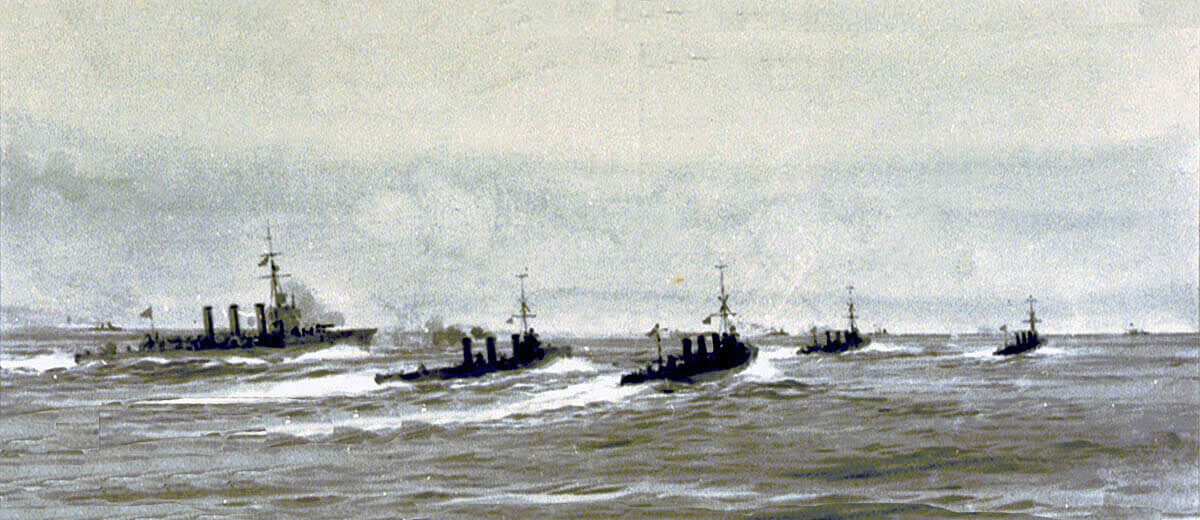
British light cruiser HMS Undaunted and the four destroyers Lance, Lennox, Legion and Loyal sight the four German torpedo boats at the beginning of the Texel action on 17th October 1914 in the First World War: picture by Lionel Wyllie
The previous battle in the First World War is the Battle of the Aisne
The next battle in the First World War is the Battle of Coronel
Battle: Texel Action
Date of the Texel Action: 17th October 1914
Place of the Texel Action: Off the Dutch coastal island of Texel.
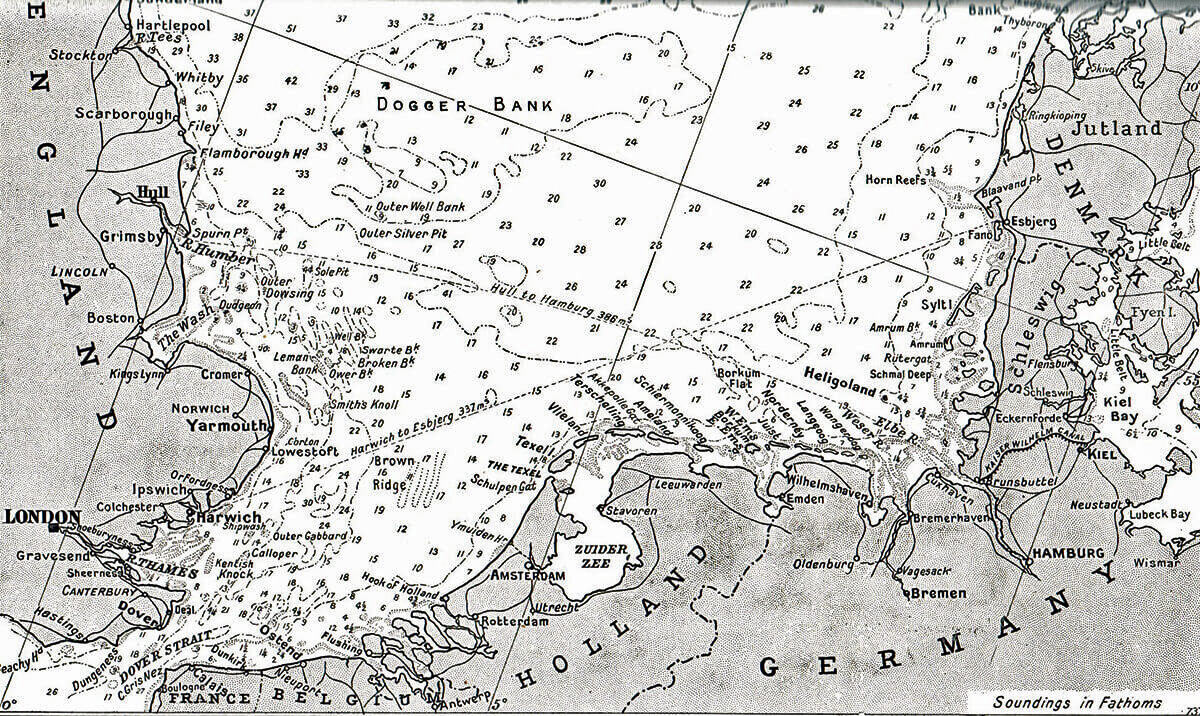
Map of the North Sea Coast of Holland and Germany showing the Dutch island of Texel where the action took place on 17th October 1914 in the First World War
War: The First World War also known as ‘The Great War’.
Contestants at the Texel Action: The British Royal Navy against the Imperial German Navy.
Ships involved in the Texel Action:
The Royal Navy:
1st Division of 3rd Destroyer Flotilla based at Harwich:
HMS Undaunted (leader of 3rd Destroyer Flotilla): light cruiser (Captain Cecil Fox) completed 1914 – 2 X 6 inch and 6 X 4 inch guns – 28.5 knots – crew 318.
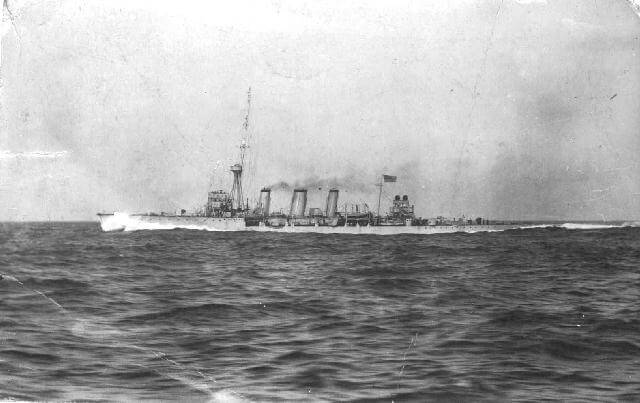
British light cruiser HMS Undaunted, the command ship at the Texel action on 17th October 1914 in the First World War
Destroyers: HMS Lance (Commander Egerton), Lennox (Lieutenant – Commander Dane), Legion (Lieutenant Allsup) (all completed 1914) and Loyal (Lieutenant Burges Watson) (completed 1913): all 3 X 4 inch guns – all 28 knots – all 77 crew.
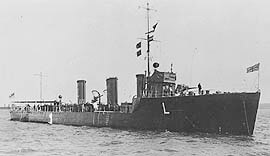
British destroyer HMS Lance one of the British destroyers at the Texel action on 17th October 1914 in the First World War
Submarine: HMS E8
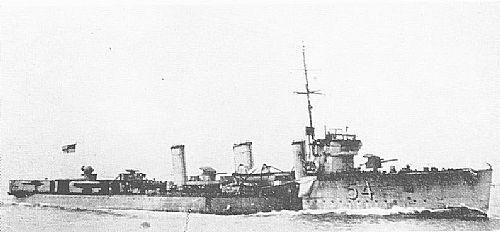
British destroyer HMS Legion one of the British destroyers at the Texel action on 17th October 1914 in the First World War
German Imperial Navy:
Torpedo Boats (S114 – 131 type): S115, S117, S118 and S119: all built around 1904 – all 3 X 1 pounder 40mm (1.6 inch) guns – all 27 knots – all 60 crew.
All these ships, British and German, were equipped with torpedo tubes.
Considerable confusion arises from the different names given by the British Royal Navy and the German Imperial Navy to torpedo boats/destroyers. With the advent of the torpedo as a naval weapon small vessels called ‘Torpedo Boats’ were developed by all advanced navies to deliver torpedo attacks on larger ships. Ships of the same size were constructed with guns of up to 4 inch calibre to counter these torpedo boats. The British called these countering ships ‘Torpedo Boat Destroyers’, a name elided to simply ‘Destroyers’. Destroyers were found to be of considerable use in providing protection to larger ships against submarines as well as torpedo boats.
The German navy continued to designate ships of that size as ‘Torpedo Boats’, even when the ship was in British parlance a ‘Destroyer’. In the case of the S114 – 131 type these ships could not be described as ‘Destroyers’. Their function was to deliver torpedo attacks and their main gun armament was small. A 40mm gun is 1.6 inches in calibre. The only effective method of fighting for these ships was to fire torpedoes. They were torpedo boats not torpedo boat destroyers.
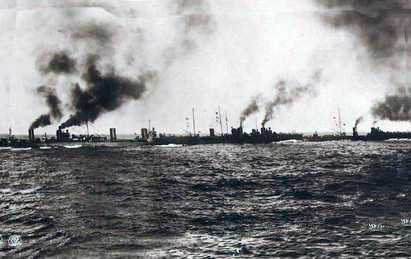
German 7th Half-Flotilla of S115, S116 (not present at the Texel action), S117, S118 and S119: Texel action on 17th October 1914 in the First World War
Commanders at the Texel Action:
The Royal Navy Ships were commanded by Captain Cecil Fox RN of HMS Undaunted.
The German 7th half-flotilla was commanded by Korvettenkapitӓn Georg Thiele of S119.
Winner of the Texel Action:
The reality is that these four German ships did not have a chance in the Texel action. The British cruiser HMS Undaunted and the four British destroyers were slightly faster than the four German torpedo boats and carried substantial gun armaments.
The action ended with the four German ships sunk and most of their officers and seamen lost.
Background to the Texel Action:
The background to this small action was the German advance through northern Belgium and the retreat of the Belgian army to a line behind the Yser River in the western corner of Belgium, following the fall of Antwerp.
A significant consequence of the Allied withdrawal was the falling into German hands of the ports of Ostend and Zeebrugge.
By 15th October 1914 the Belgian Army was in its new position stretching some thirty miles along the Yser River and Yser Canal. With only six divisions, exhausted by its fighting retreat and with little heavy artillery the Belgian force was a vulnerable section of the Allied line, with the Germans already in Ostend.
On the evening of 15th October 1914 a request was passed to the Royal Navy for ships to bombard the German army formations and artillery along the Belgian coast.
The Admiralty was aware of the danger to Dover from the German advance through Antwerp to Zeebrugge and the other Channel ports and preparations were already under way to provide additional cover for Dover and ships to assist the Belgian land forces.
On 12th October 1914 a new naval command was established, the ‘Dover Patrol’, and Rear – Admiral the Hon. H.L.A. Hood appointed to command it. The Dover Patrol comprised the 6th or Dover Destroyer Flotilla of twenty four Tribal Class Destroyers and four attached light cruisers, two submarine flotillas and the Downs Boarding Flotilla.
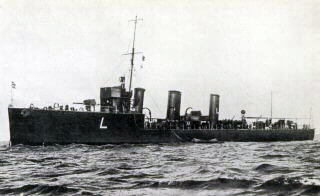
British destroyer HMS Lennox one of the British destroyers at the Texel action on 17th October 1914 in the First World War
During the night of 15th/16th October 1914 reports came in of substantial German troop advances towards the Belgian line. General Joffre repeated the request for a naval bombardment of the German forces to bolster the Belgians in their resistance against the impending powerful attack.
Account of the Texel Action:
During the evening of 16th October the British Admiralty received warning of significant German naval activity in the Heligoland Bight, perhaps indicating a German intention to intervene in support of the German land offensive against the Belgian Army on the Yser River.
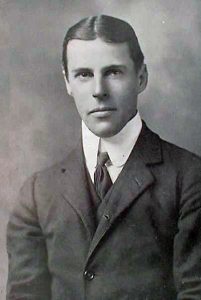
Captain Cecil Fox RN commander of the British force at the Texel action on 17th October 1914 in the First World War and captain of HMS Undaunted:
A naval force from the Harwich Squadron was despatched to investigate the reports, comprising the light cruiser HMS Undaunted (Captain Cecil Fox) and the 1st Division of 3rd Destroyer Flotilla; destroyers Lance, Lennox, Legion and Loyal.
A British submarine, E8, positioned between Terschelling and Ameland, watched for German naval activity in the Heligoland Bight.
At 2pm on 17th October 1914 HMS Undaunted and the four destroyers reached the Dutch coast east of Brown Ridge and began their patrol on a course east of north up the coast.
Reaching a point fifty miles to the south-west of Texel Island the British ships saw smoke columns from four ships about eight miles ahead. These ships proved to be of German torpedo boat/destroyer size vessels steaming line abreast half a mile apart, on much the same course as the British ships.
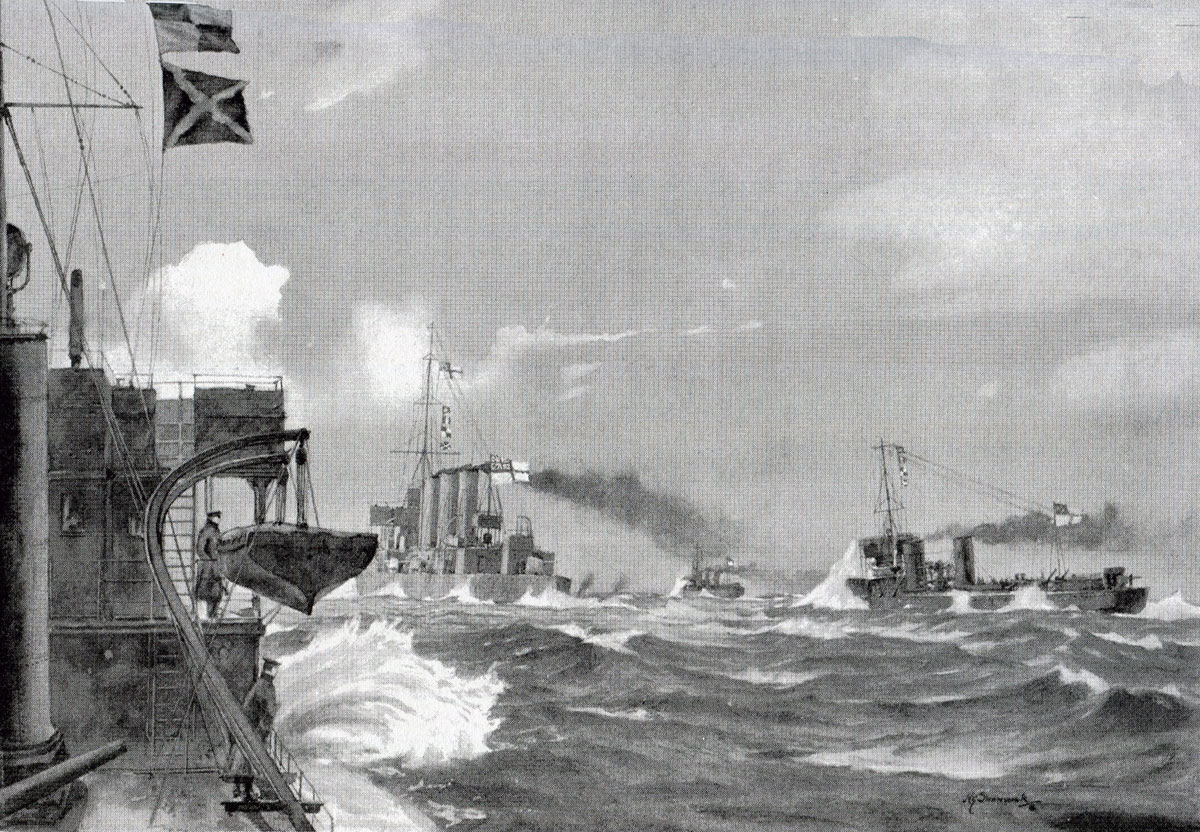
HMS Undaunted and the four British destroyers sight the four German torpedo boats in the Texel action on 17th October 1914 in the First World War: picture by H.G. Swanwick
The German ships, which were quickly shown to be four torpedo boats rather than destroyers, fanned out and attempted to make off at the best speed they could, continuing on their course towards the German bases to the north-east.
The German ships were from right to left; S115 nearest the coast, S117 and S118, with S119, the half-flotilla commander, furthest out to sea. As they attempted to escape the torpedo boats fanned out still further.
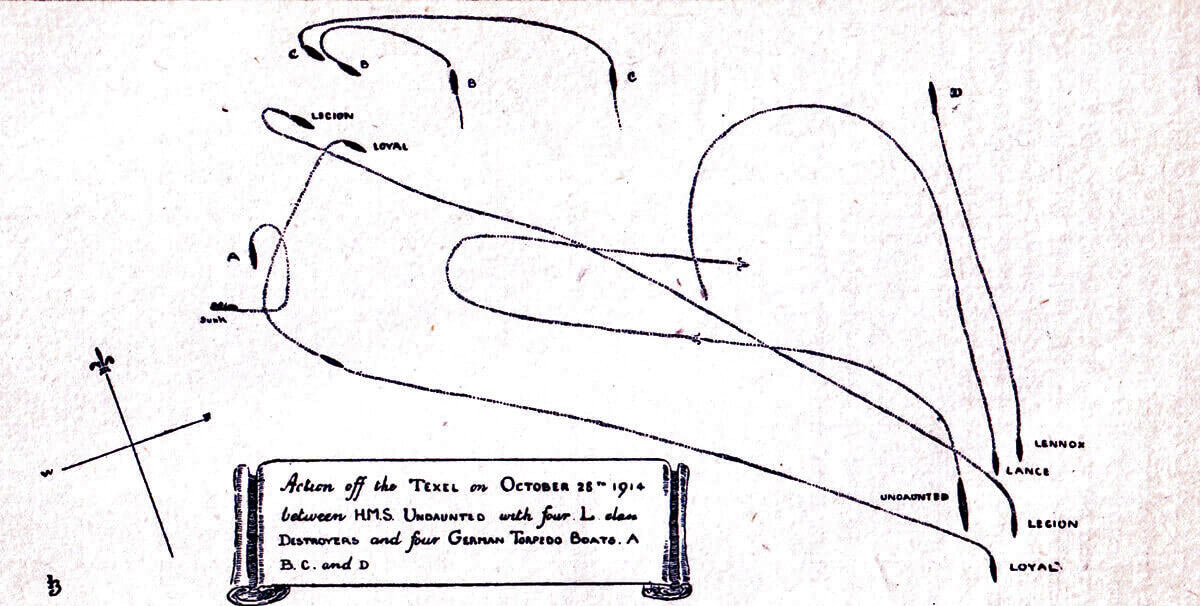
Plan of the Texel action on 17th October 1914 in the First World War, drawn by a participant: A = S119, B = S118, C = S117 and D = S115
Undaunted signalled ‘General Chase’, the order giving each British ship a discretion on how she pursued the enemy.
On the right Lennox and Lance steamed to head off S115 from getting away into Heligoland Bight. On the left Loyal made to prevent S119 from escaping out to sea, while Legion pursued S117 and S118. Undaunted remained in the centre. The British ships were all faster than the German torpedo boats and began to catch them up. S118 suffered from engine trouble and struggled to keep up with the rest of the half-flotilla.
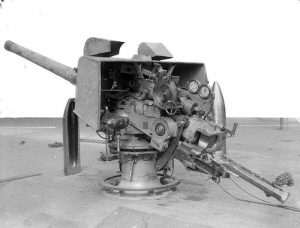
4 inch gun from HMS Lance, reputed to have fired the first naval shot in anger of the Great War at the German passenger steamer turned minelayer Königin Luise on 5th August 1914
Once the range fell to 8,000 yards (4 ½ miles) Undaunted opened fire with her 6 inch guns on each German ship in turn. The torpedo boats made repeated changes in course to confuse the British gun crews, initially preserving them from damage, but significantly reducing their speed of escape. The range fell and the British shots began to strike the German torpedo boats.
By around 3pm the British ships were making significant hits on the German ships. Lennox and Lance quickly reduced S115 to a sinking condition. The other German torpedo boats turned back to engage the British ships, S119 attacking Loyal, while S117 and S118 attacked Legion and Undaunted.
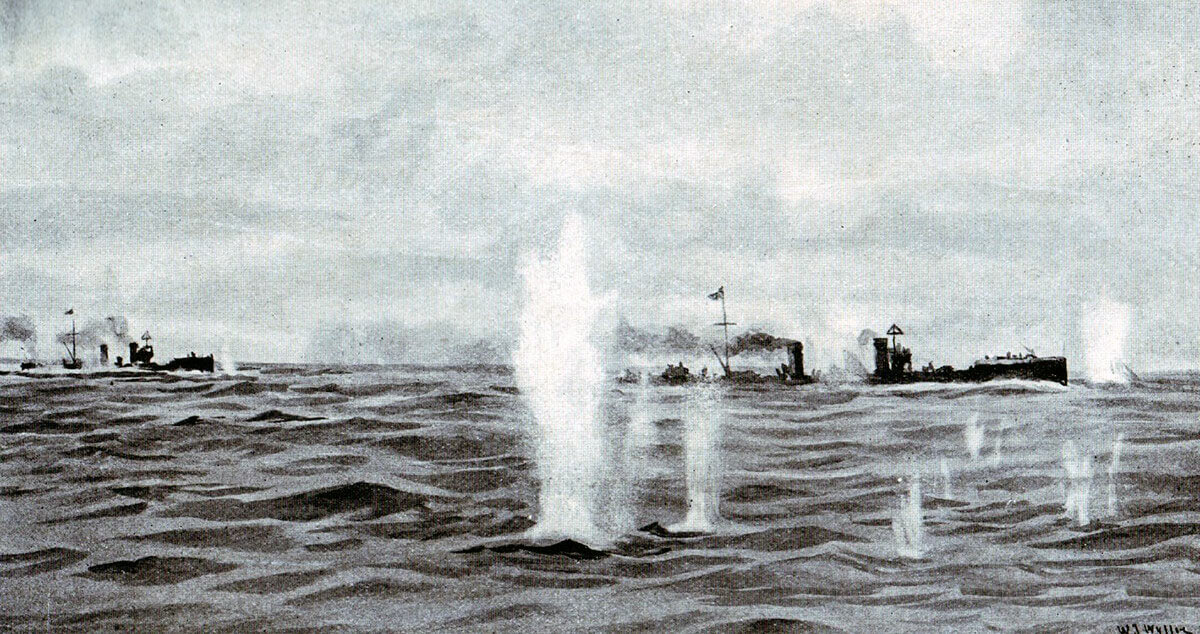
German torpedo boats under fire in the Texel action on 17th October 1914 in the First World War: picture by Lionel Wyllie
Loyal quickly reduced S119 to a ruin with her gunfire, destroying her funnels, bridge and deck fittings, putting her out of action and killing most of her crew, before turning on the remaining two German ships.
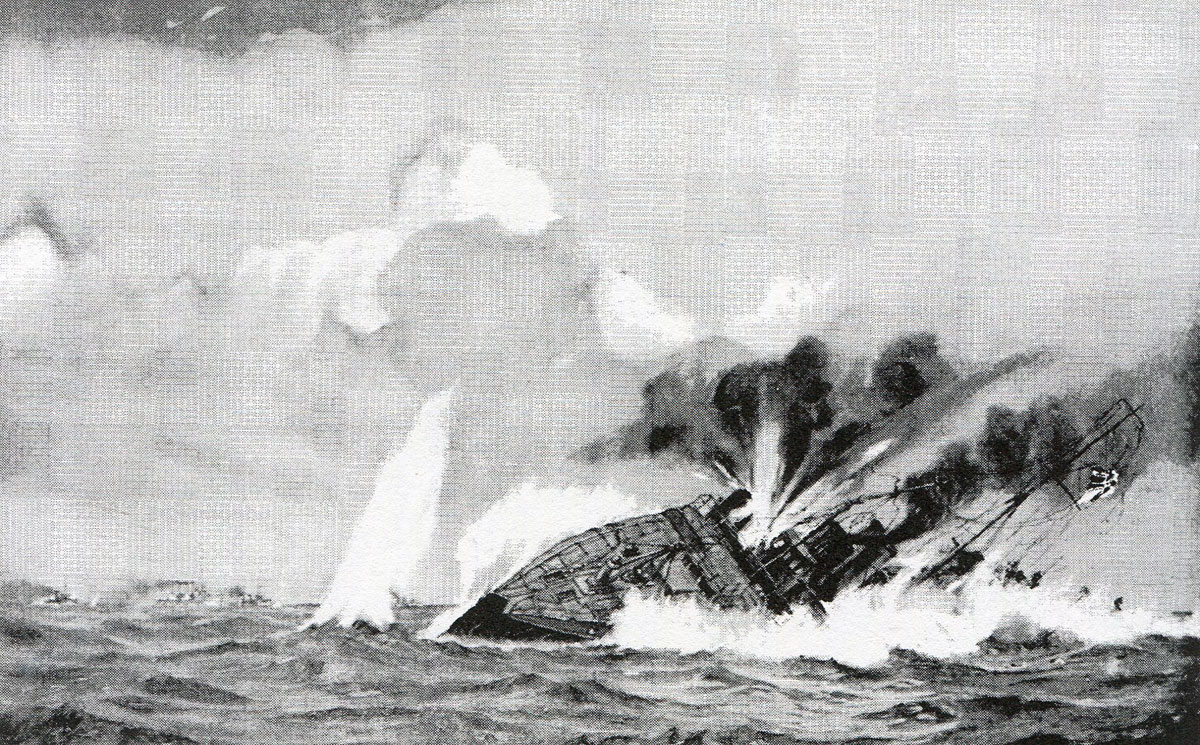
German torpedo boat S119 sinks in the Texel action on 17th October 1914 in the First World War: picture by H.G. Swanwick
Lance left Lennox to finish off S115 and joined in the attack on S117 and S118, who were attempting to defend themselves with machine gun fire and discharges of torpedoes at Undaunted.
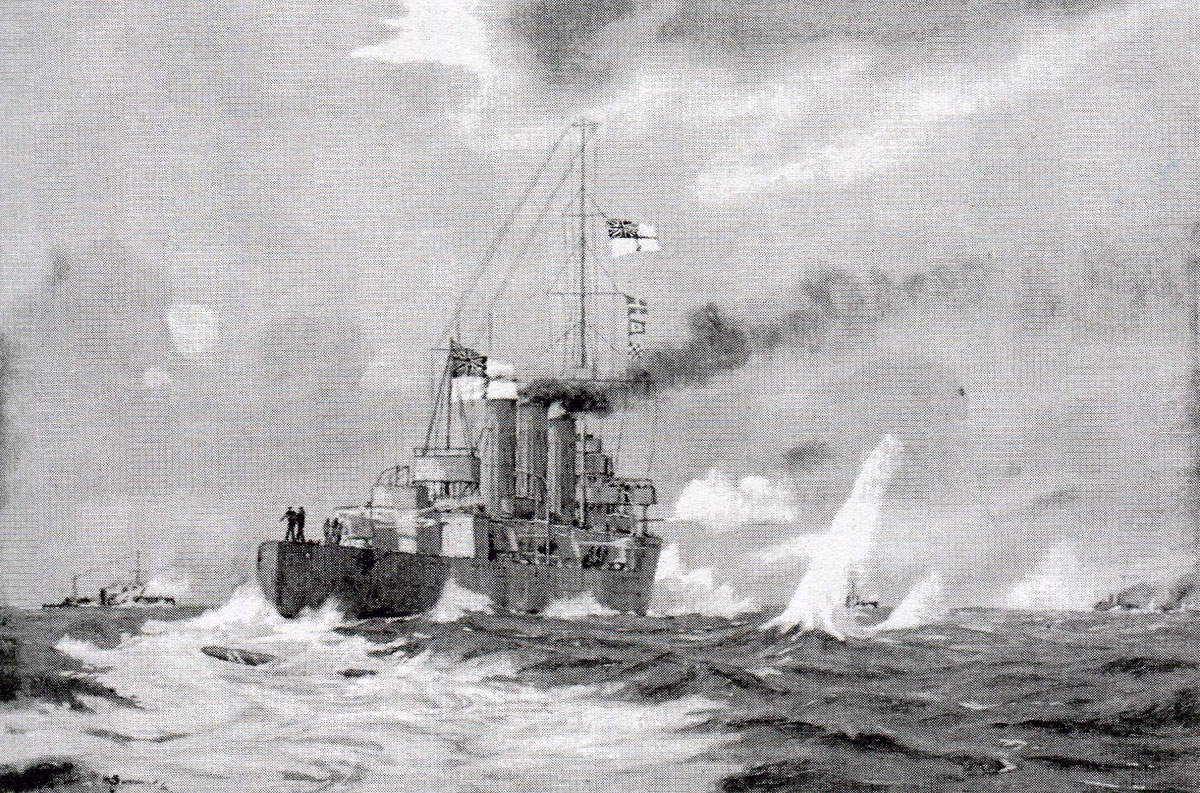
HMS Undaunted evades a German torpedo in the Texel action on 17th October 1914 in the First World War: picture by H.G. Swanwick
The British light cruiser turned away to starboard to avoid the torpedo attack and continued to fire on the surviving German torpedo boats.
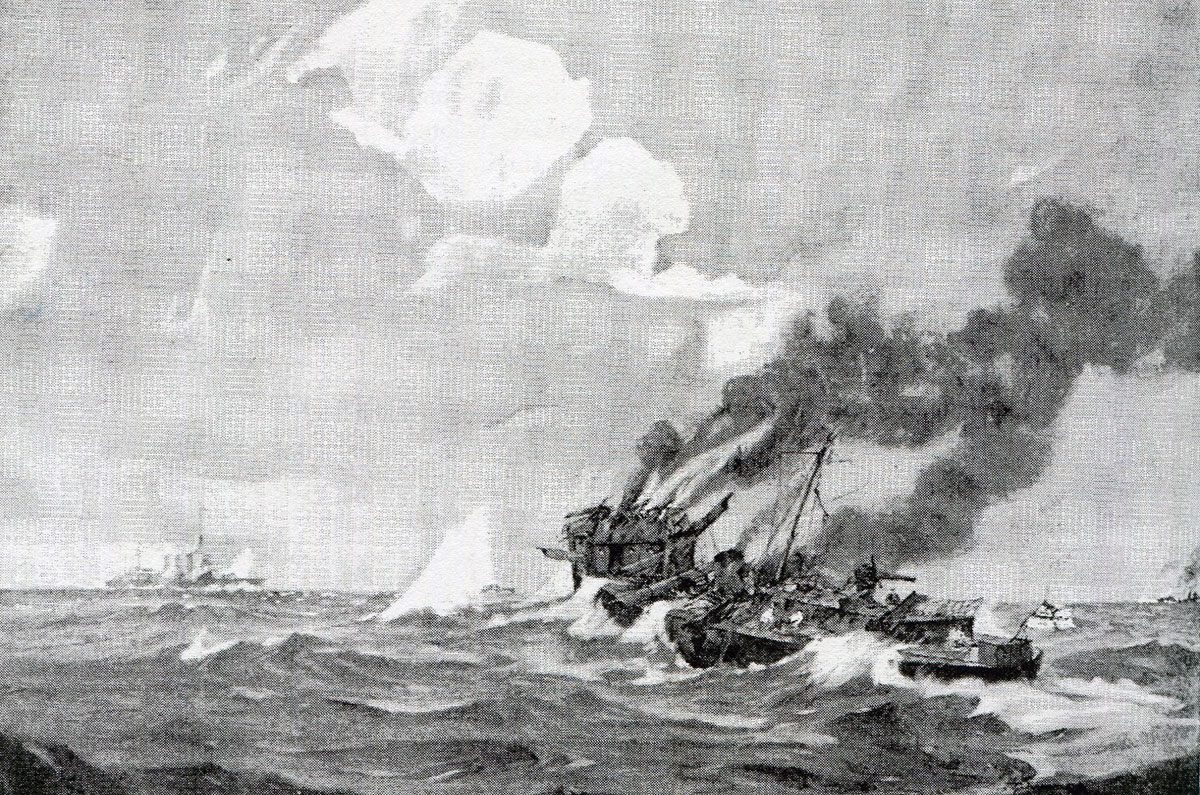
German torpedo boat S117 about to sink in the Texel action on 17th October 1914 in the First World War: picture by H.G. Swanwick
By 4.30pm all four German ships were sunk.
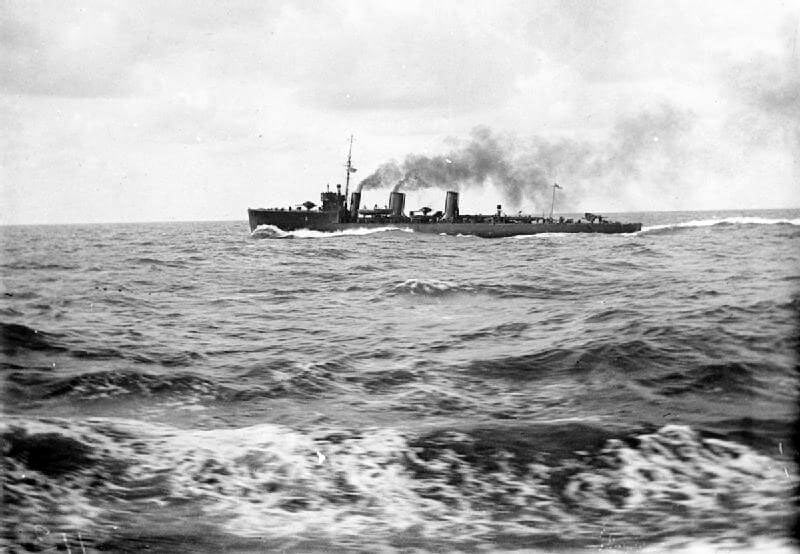
British destroyer HMS Loyal one of the British destroyers at the Texel action on 17th October 1914 in the First World War
Casualties at the Texel Action:
One German captain was rescued, but died soon afterwards. A further German officer and thirty-one sailors were rescued by the British ships. Two German sailors were picked up by a Dutch ship. Two hundred and twenty three German officers and sailors died in the action. British casualties were one officer and four seamen wounded, of whom one subsequently died.
The British ships suffered little damage.
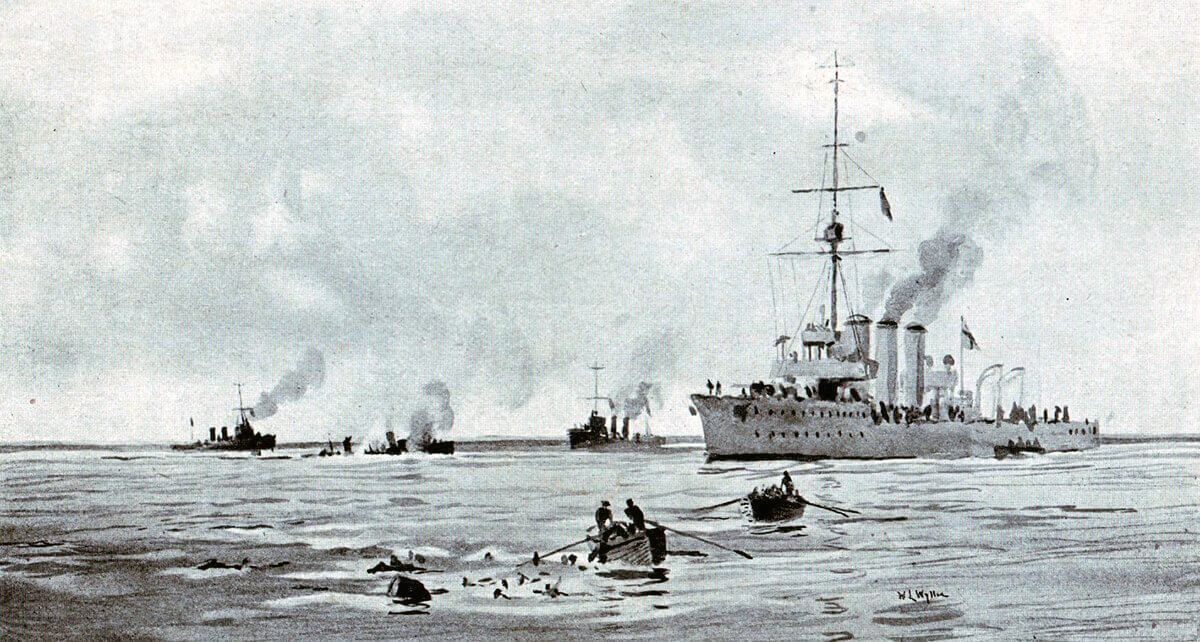
The British ships rescuing survivors among the German crews from the four torpedo boats sunk in the Texel action on 17th October 1914 in the First World War: picture by Lionel Wyllie
Aftermath to the Texel Action:
Official German reports stated that the four German torpedo boats were on their way to lay mines along the British coast when the action took place. This seems unlikely. Mines on any of the torpedo boats’ decks when they were struck by shell-fire would have caused a prodigious explosion that would have blown the ship to pieces. No such occurrence was reported by the British ships, nor did any of the German prisoners state that this was the nature of their operation. It was the British assumption that the German torpedo boats were on their way to attack British naval units off the Belgian coast or in some other way to intervene in the land fighting, perhaps by transferring German troops along the coast.
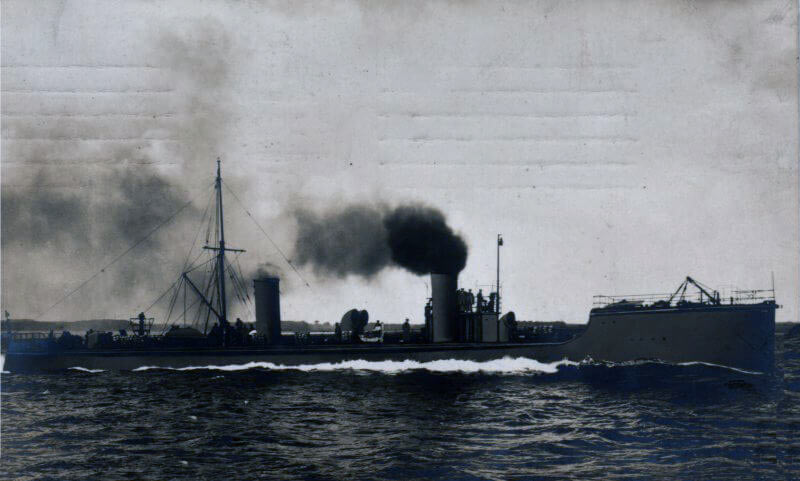
German torpedo boat similar to the German ships in the Texel action on 17th October 1914 in the First World War
The German naval authorities clearly overestimated the ability of their torpedo boats to defend themselves in a general surface action. They were too slow and inadequately armed. Texel showed the substantial German fleet of torpedo boats to be largely useless.
The moral effect of the loss of the four German torpedo boats was substantial. The German authorities were dismayed at this further Royal Navy success and its impact on German morale. Torpedo boats were taken off offensive patrols, relegated to coastal work, and the German navy constrained yet further in its operations in the North Sea.
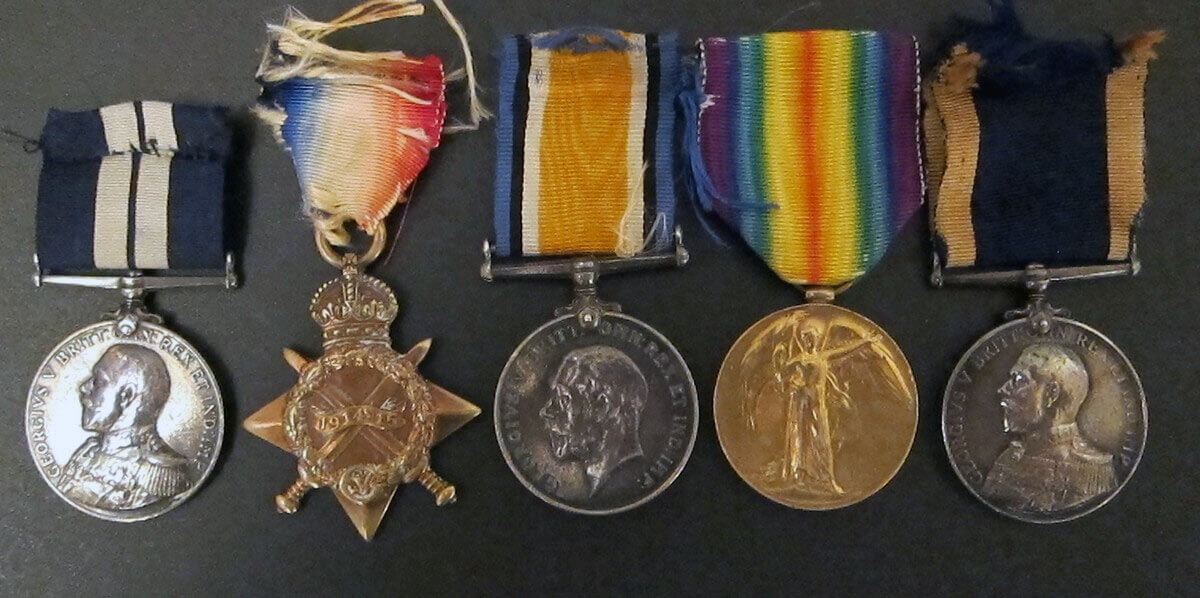
Medals of Chief Stoker Johnson of HMS Lennox, including the Distinguished Service Medal awarded for his conduct in the Texel action on 17th October 1914 in the First World War (left)
Great propaganda use was made of the Texel action in Britain. For this purpose the German ships were widely mis-described as ‘Destroyers’.
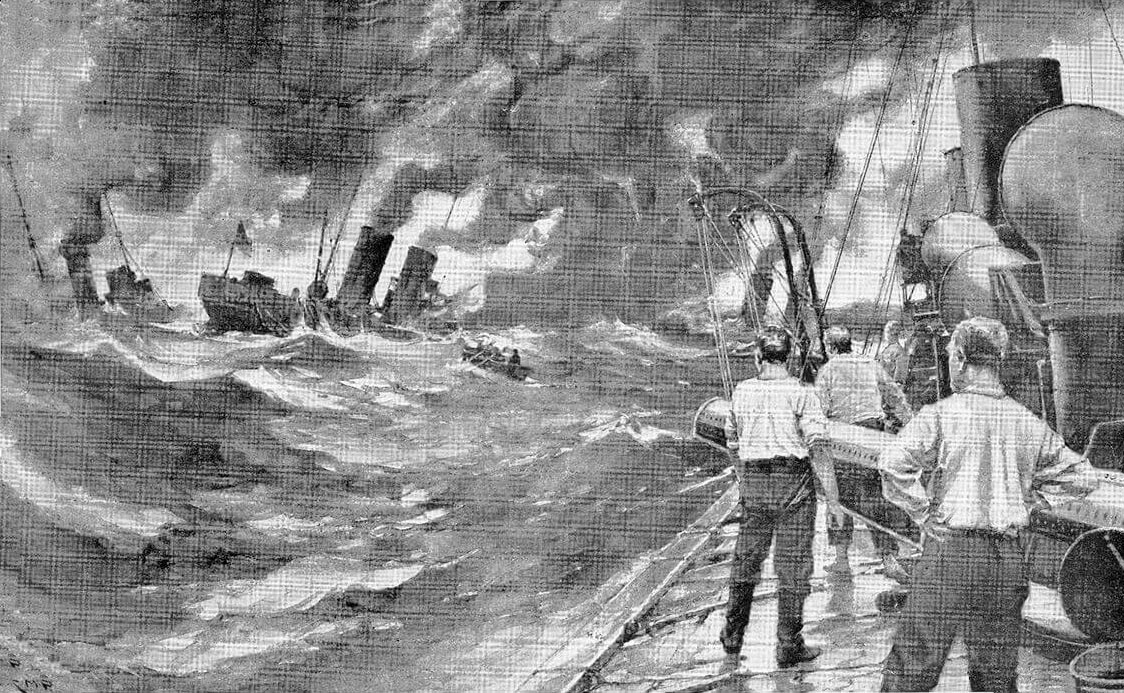
Illustration of the sinking of the German torpedo boats, under the caption ‘Sunk the lot’: Texel action on 17th October 1914 in the First World War
Anecdotes and traditions from the Texel Action:
• The British ‘official’ report of the Texel action at the time stated: ‘.. Undaunted accompanied by the destroyers Lance Legion and Loyal [Lennox seems to have be omitted] engaged four German destroyers off the Dutch coast yesterday afternoon. All the enemy’s destroyers were sunk…’
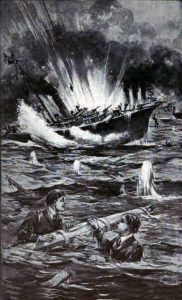
Illustration from the novel ‘The Boy Allies Under Two Flags’: Texel action on 17th October 1914 in the First World War
• The Times History of the War states of the action: ‘The German destroyers were older boats, carrying only two 23-pounder guns, and not only were they slower, but there was absolutely no comparison between the accuracy of their shooting and that of the British craft engaged’.
The German ships were equipped with 1 pounders not 23 pounders and in every action involving the Imperial German Navy a striking feature of their performance was the accuracy of their shooting. As at Texel a further consistent feature of German naval conduct was the courage of their officers and crews in the most adverse of situations, in addition to their outstanding professional competence.
• The Texel action appeared in a novel written in 1915, The Boy Allies under Two Flags by Ensign Robert L. Drake. The German ships were described as ‘Destroyers’.
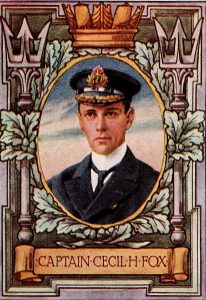
Captain Fox of HMS Undaunted, British commander in the Texel action on 17th October 1914 in the First World War: one of a series of heroic pictures published early in the Great War
• In ‘Sea Fights of the Great War’ written by W.F. Wren and illustrated by the incomparable naval artist William Lionel Wyllie, the German ships were described correctly as ‘Torpedo Boats’. Wyllie’s illustration of the German ships is accurate and reflects his extensive pre-war knowledge of the German navy. Wyllie was given substantial assistance by the Admiralty and enabled to go to sea with the Royal Navy. The book was prepared during the War and published in 1918.
• Captain Cecil Fox, the British commander in the Texel action, experienced an eventful few months at the beginning of the war. His initial command was the light cruiser HMS Amphion. Amphion took part in the first naval sinking of the War, the German passenger steamer converted to minelayer, Königin Luise, sunk in the North Sea on 5th August 1914 by HMS Amphion, HMS Lance and other destroyers (recorded by Lionel Wyllie). The next morning Amphion, still carrying surviving crew members from Königin Luise, struck two mines while returning to Harwich through the area just mined by the German navy and sank with substantial loss of life including German prisoners. Fox described seeing one of the 6 inch guns flying up into the air. Fox was appointed to command HMS Faulkner and on 15th October 1914 moved to command HMS Undaunted. Fox was relieved of his command soon after the Texel action, spending the rest of his naval career ashore and retiring as a rear admiral in 1922.
• Captain Fox is reported to have begun the chase with a radio message ‘am pursuing four German destroyers’ and ended it with the radio message ‘sunk the lot’.
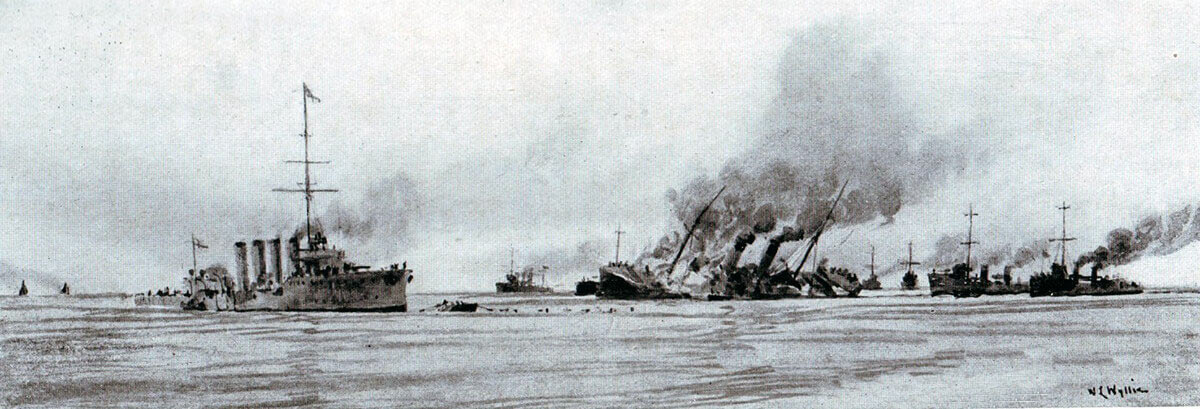
Sinking of the German minelayer Königin Luise on 5th August 1914 in the First World War. Shown are HMS Amphion and HMS Lance. Picture by Lionel Wyllie
• The sinking of HMS Amphion was recorded on camera from one of the British destroyers. This photograph was used by publications to illustrate the sinking of the German ships in the Texel action. Amphion was a four funnel ship while the German Torpedo Boats were two funnel ships with the funnels widely spaced. The ship sinking in the photograph appears to be a four funnel ship. Other features make it unlikely that the photograph is of the German ships: the effect of British shellfire was to destroy the German ships’ superstructure before they sank and there is no sign of such damage in the photograph; it is unlikely that a British ship would have been close to a German ship until after it sank while the British destroyers closed in on Amphion to rescue the crew.
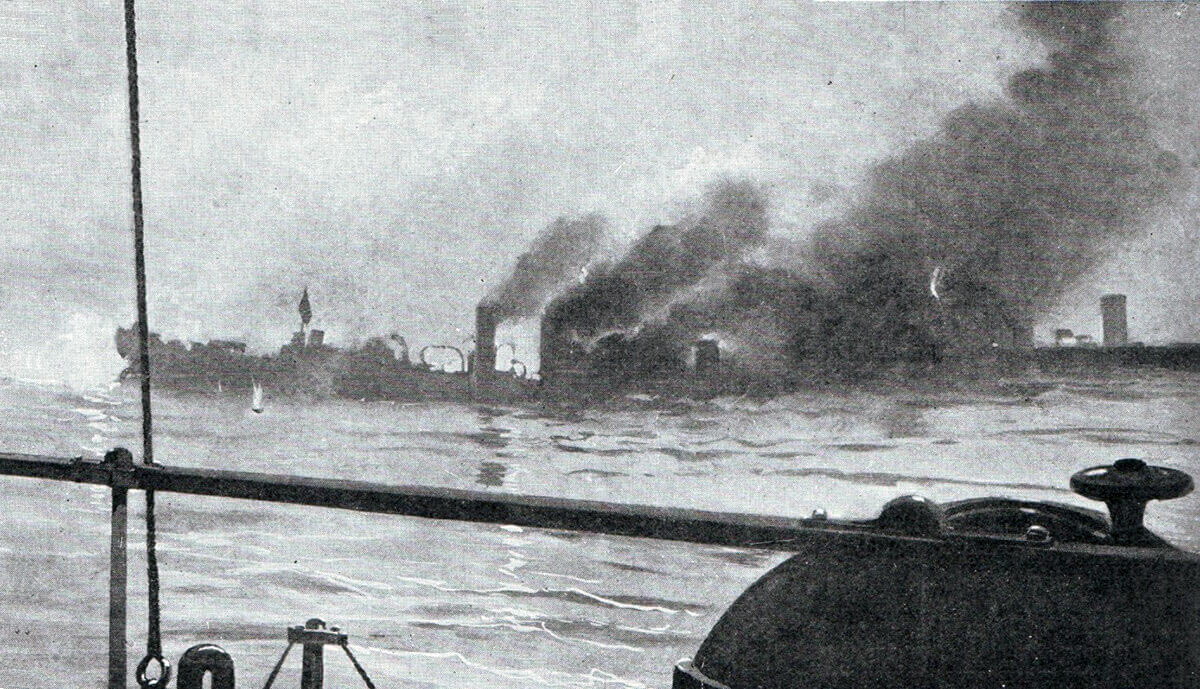
Photograph showing either the sinking of HMS Amphion on 6th August 1914 or the German torpedo boats at Texel on 17th October 1914, in the First World War
• Following the Texel action the Royal Navy boarded a German civilian ship, the Ophelia. The German authorities claimed the Ophelia was a hospital ship sent to rescue survivors of the four German torpedo boats. The Ophelia’s conduct and documentation aboard led the Royal Navy to believe the ship was scouting for a German naval incursion into the Channel. She was detained.
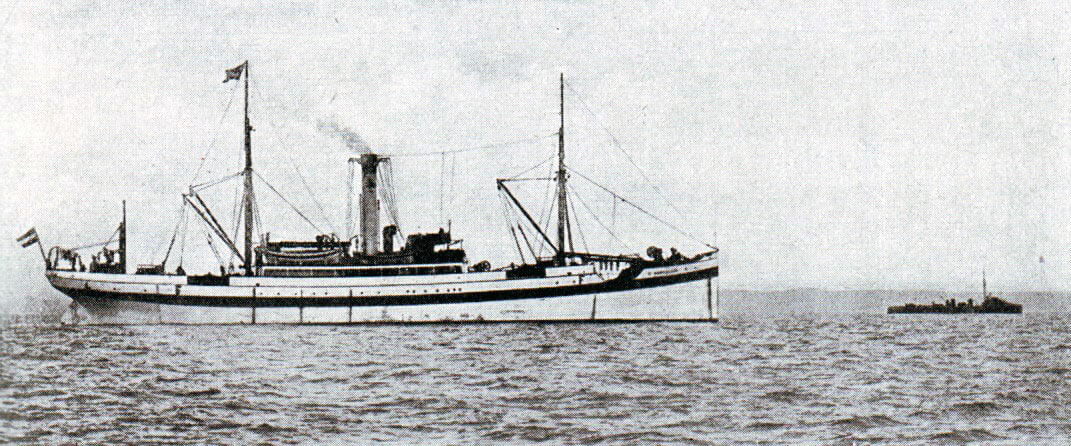
German ship Ophelia, that the Germans claimed to be a hospital ship, detained by the Royal Navy following the Texel action on 17th October 1914 in the First World War
• On 30th November 1914 a British trawler, fishing in the area of the Texel action, fished up a sealed box containing code books thrown overboard by Captain Thiele of S119. The British navy was enabled thereby to monitor German light vessel coastal communications.
• A Second World War German destroyer was named after Korvettenkapitӓn Georg Thiele. The Georg Thiele was sunk in Norway in 1940.
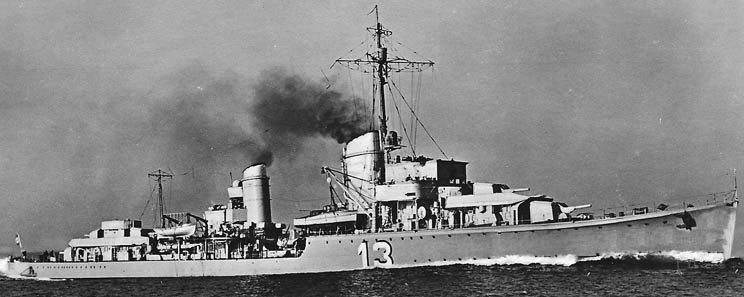
Second World War German destroyer named Georg Thiele in memory of the commander of S119 and the German 7th Half-flotilla, lost in the Texel action on 17th October 1914 in the First World War
References for the Texel Action:
Naval Operations in the Great War Volume 1 by Sir Julian Corbett
Jane’s Fighting Ships of World War 1
Times History of the Great War Volume 2
Sea Fights by WL Wyllie and MF Wren
The previous battle in the First World War is the Battle of the Aisne
The next battle in the First World War is the Battle of Coronel
